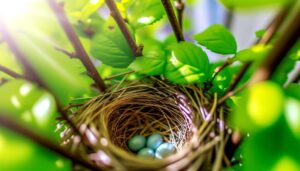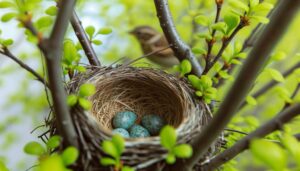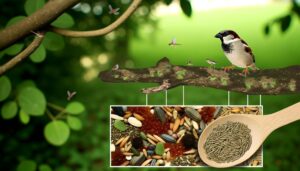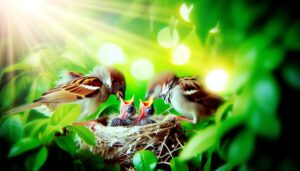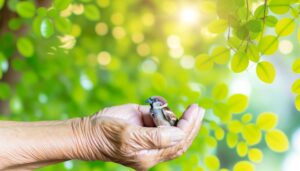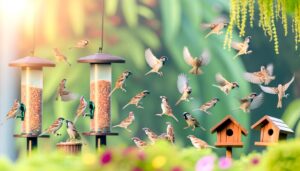How Long Do Java Sparrow Eggs Take to Hatch?
Java Sparrow eggs generally hatch within 12 to 16 days. Best ambient temperatures, particularly between 37 and 39 degrees Celsius, play a vital role.
Humidity levels from 50-70% are necessary for proper moisture retention and gas exchange. Parental behavior and nesting conditions profoundly influence uniform embryonic development.
Factors such as genetic health, nutrition, and stress levels also impact fertility and viability. Consistent temperature and humidity monitoring are essential to reduce the risk of mortality and deformities.
Understanding the complete range of incubation dynamics and post-hatch care can greatly contribute to successful outcomes.

Key Takeaways
- Java Sparrow eggs typically hatch within 12 to 16 days.
- Optimal hatching temperature ranges from 37 to 39 degrees Celsius.
- Humidity levels between 50-70% are crucial for successful hatching.
- Consistent temperature control ensures embryo viability and healthy development.
- Parental behaviors and nesting conditions significantly impact hatching success.
Typical Incubation Duration
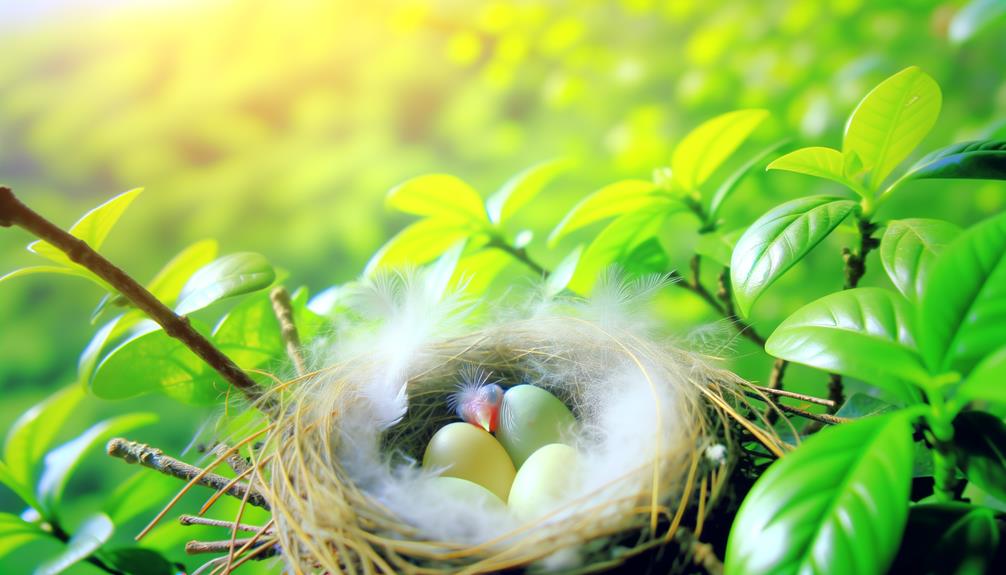
The typical hatching time for Java Sparrow eggs varies between 12 to 16 days, depending on environmental factors and parental care. This period can be influenced by ambient temperature, humidity, and the consistency of parental incubation behaviors.
Best temperature conditions generally fall within a narrow range, around 37 to 39 degrees Celsius, to guarantee proper embryonic development. Deviations from these conditions can lengthen or shorten the hatching period. Humidity levels also play a vital role, as they affect the egg's moisture retention and gas exchange.
Additionally, the attentiveness and regularity with which the parent birds turn and warm the eggs are important for uniform development. Understanding these variables provides insight into the physiological needs and adaptive behaviors of Java Sparrows during the hatching period.
Egg Fertility and Viability
Considering the factors affecting incubation duration, egg fertility and viability are equally critical in determining successful hatching outcomes for Java Sparrows. Fertility refers to the egg's ability to be fertilized, while viability indicates the embryo's capacity to develop successfully. Both are influenced by genetic and environmental factors, including parental health and age.
The following aspects significantly impact fertility and viability:
- Genetic Integrity: Genetic mutations can impair embryo development.
- Parental Health: Nutritional deficiencies in parents can lead to non-viable eggs.
- Environmental Stressors: High stress levels in the nesting environment can reduce fertility rates.
- Egg Handling: Improper handling during incubation can damage the embryo.
Understanding these factors is essential for optimizing hatching success in Java Sparrows.
Ideal Nesting Conditions
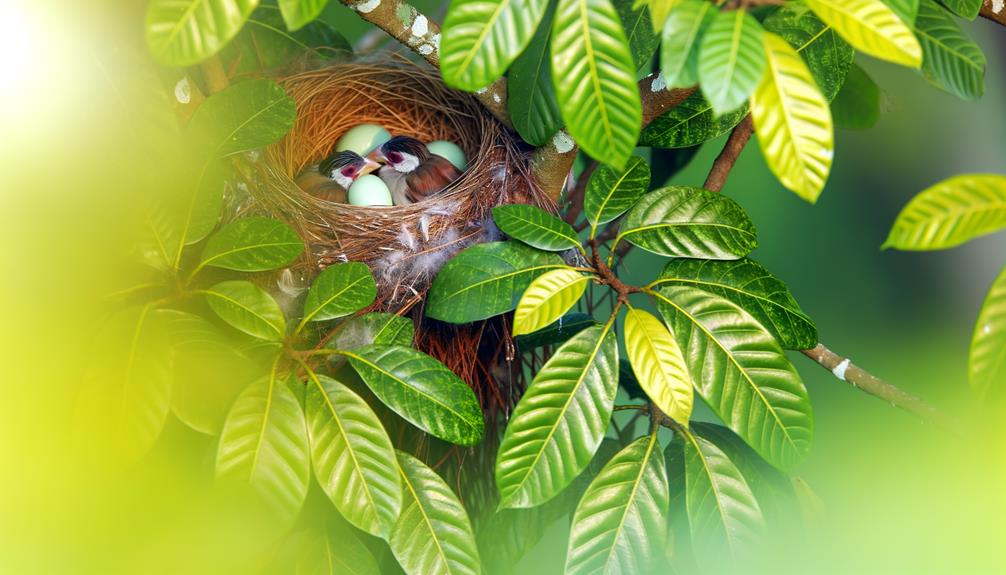
Ideal nesting conditions for Java Sparrows require meticulous attention to environmental parameters such as temperature, humidity, and nesting material quality, all of which greatly influence incubation outcomes. Nesting sites should be located in a quiet, low-traffic area to minimize stress on the birds.
Optimal humidity levels should be maintained between 50% and 70%, as deviations can affect the egg's moisture content and viability. Nesting materials should include soft fibers such as coconut husk, dried grasses, and feathers to provide insulation and comfort.
Additionally, the nest structure should allow for adequate ventilation to prevent mold growth and ensure a stable microclimate. These conditions collectively create an environment conducive to successful hatching and healthy chick development.
Temperature Requirements
Maintaining a consistent temperature of around 37.5°C (99.5°F) is crucial for the successful incubation of Java Sparrow eggs. Deviations from this ideal temperature can lead to significant embryonic mortality or developmental abnormalities. Conducting a thorough analysis, one can conclude that precise temperature control is paramount.
The importance of temperature regulation can be summarized as follows:
- Embryo Viability: Ensures the highest survival rate of embryos.
- Healthy Development: Promotes normal physiological and anatomical development.
- Hatch Synchronization: Facilitates uniform hatching times, reducing stress on chicks.
- Minimized Risks: Reduces the risk of diseases and deformities due to temperature fluctuations.
Humidity Levels
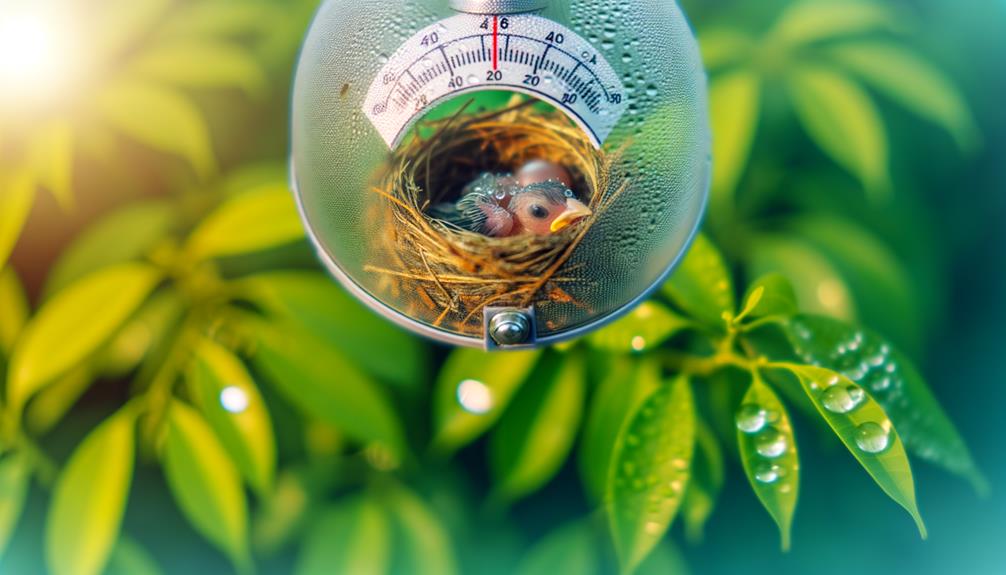
Maintaining an ideal humidity range is essential for the successful incubation of Java Sparrow eggs. Perfect levels typically fall between 50% and 60%. Accurate monitoring of humidity levels is necessary to secure a stable environment, as fluctuations can greatly affect embryonic development.
Inadequate humidity can lead to desiccation of the eggs, resulting in low hatching rates and compromised chick viability.
Ideal Humidity Range
Achieving the best humidity range is essential for the successful incubation and hatching of Java sparrow eggs. Optimum humidity guarantees proper embryonic development and prevents desiccation or excess moisture, which can be harmful.
The ideal humidity range for incubating these eggs typically falls between 50% and 60%. This range promotes:
- Balanced Water Loss: Ensuring the embryo loses the correct amount of water.
- Gas Exchange Efficiency: Facilitating effective oxygen intake and carbon dioxide expulsion.
- Prevention of Mold: Reducing the risk of fungal infections that can compromise egg viability.
- Shell Integrity: Maintaining the strength and flexibility of the eggshell.
Understanding these humidity parameters is essential for breeders aiming for high hatch rates and healthy chicks.
Monitoring Humidity Levels
Effective monitoring of humidity levels is essential for ensuring the finest incubation environment for Java sparrow eggs. Precise hygrometers and consistent observation can help maintain the best humidity levels. It's critical to keep the humidity within the ideal range, typically between 50-60%, to prevent complications in the embryonic development.
| Instrument | Function |
|---|---|
| Hygrometer | Measures humidity levels |
| Humidifier | Adds moisture to air |
| Dehumidifier | Reduces air moisture |
Regular adjustments based on hygrometer readings help in maintaining the delicate balance needed for successful hatching. A deviation from the ideal range can lead to less than ideal conditions, affecting the eggs' viability. Utilizing reliable instruments and adhering to a consistent monitoring schedule are key components in the incubation process.
Effects of Low Humidity
Insufficient humidity levels during the incubation period can lead to significant developmental issues in Java sparrow embryos, potentially resulting in desiccation and impaired hatching success. Low humidity disrupts the delicate moisture balance necessary for proper embryonic development. This desiccation can cause:
- Embryonic Death: Vital fluids evaporate, leading to embryo dehydration and death.
- Deformed Chicks: Insufficient moisture can cause malformations or improper development.
- Stuck Chicks: Low humidity makes it difficult for chicks to break through the eggshell, resulting in exhaustion or death.
- Reduced Hatch Rate: Overall, low humidity can drastically decrease the number of successfully hatched chicks.
Maintaining optimal humidity is crucial to avoid these severe consequences and ensure the health and viability of Java sparrow offspring.
Parental Roles in Incubation
In the incubation process of Java sparrow eggs, both the male and female share responsibilities, contributing equally to the warmth and protection needed for successful hatching. This biparental care involves alternating incubation shifts, ensuring continuous coverage of the eggs.
Typically, males incubate during daylight hours while females take over at night. This division of labor maximizes efficiency, allowing each parent periods of rest and foraging. The synchronized efforts of both parents maintain the eggs at an ideal temperature of around 37.5°C (99.5°F), vital for embryonic development.
In addition, both parents engage in meticulous nest maintenance, rearranging nesting materials to enhance insulation and security, thereby safeguarding the eggs from potential environmental stressors.
Monitoring Egg Development
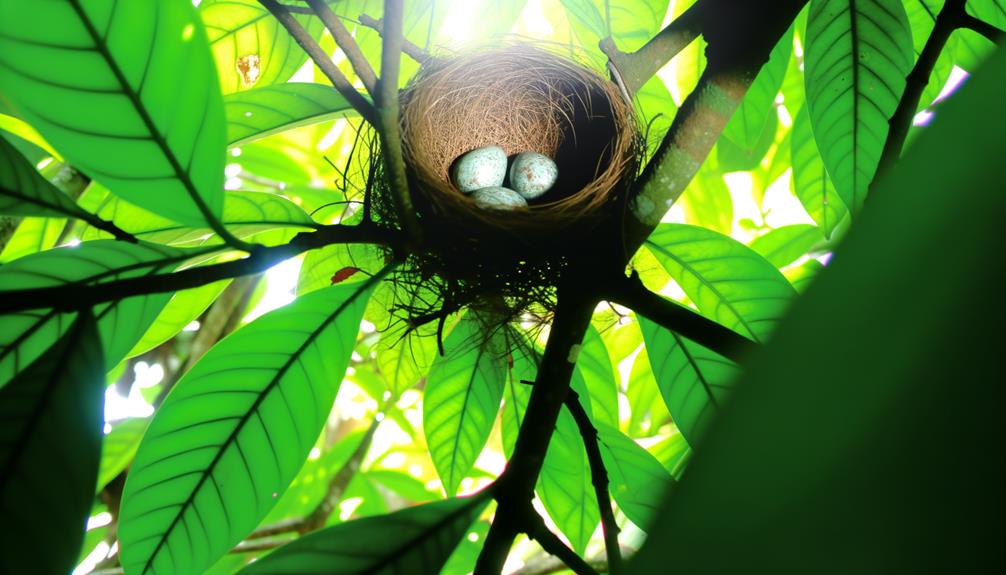
Monitoring the development of Java sparrow eggs demands a meticulous approach, involving regular observation and precise measurement of key indicators such as egg mass, shell condition, and embryonic growth stages. Accurate documentation of these factors allows for a detailed understanding of the incubation process and early detection of potential issues.
Consider these critical elements when tracking egg development:
- Egg Mass: Regularly weighing the eggs can reveal changes in moisture content and embryonic growth.
- Shell Condition: Evaluating the shell for cracks or abnormalities ensures the egg's protective barrier remains intact.
- Embryonic Growth: Candling the egg to monitor the embryo's development provides insights into its well-being and progress.
- Temperature and Humidity: Maintaining optimal environmental conditions is crucial for proper embryonic development.
Signs of Hatching
As the incubation period progresses, certain key indicators signal the imminent hatching of Java sparrow eggs, requiring a close examination of these signs to guarantee the successful emergence of the chicks. Observing initial external pipping, where the chick first breaks the eggshell, is essential. Additionally, increased movement within the egg can be detected through candling. Auditory cues, such as faint peeping sounds, also indicate that hatching is near.
| Indicator | Description | Importance |
|---|---|---|
| External Pipping | First visible break in the eggshell | Signifies the start of hatching |
| Increased Movement | Detectable via candling | Indicates chick's readiness to hatch |
| Auditory Clues | Faint peeping sounds from within the egg | Confirms chick vitality and effort |
These signs should be meticulously monitored to ensure ideal hatching conditions.
Common Hatching Problems
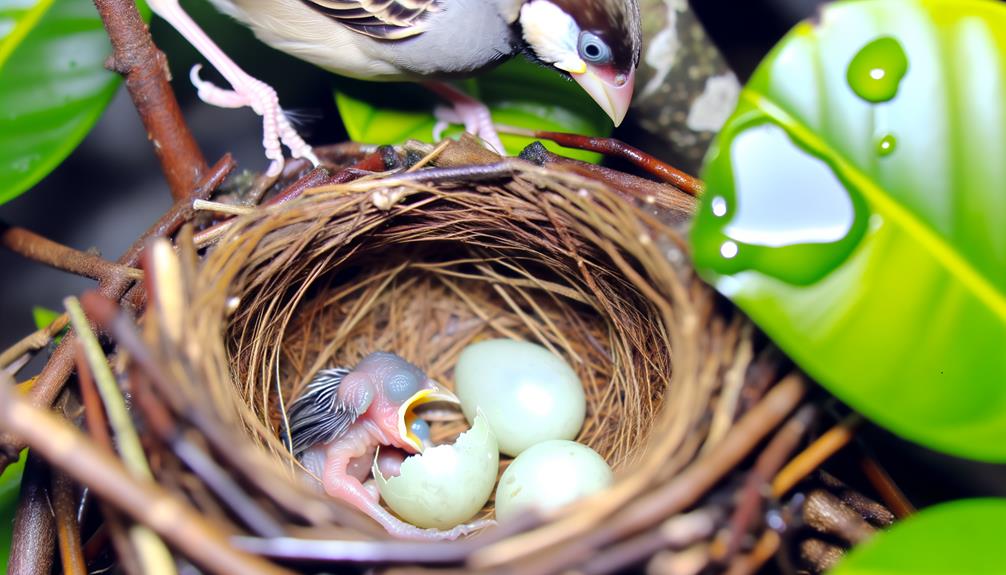
Despite meticulous care, several common hatching problems can arise, potentially jeopardizing the successful emergence of Java sparrow chicks. These issues are frequently rooted in environmental, genetic, or health factors that require vigilant observation and intervention.
- Temperature Fluctuations: Incorrect incubation temperatures can lead to developmental abnormalities or non-viable embryos.
- Humidity Levels: Inadequate humidity can cause the eggshell to become too hard, making it difficult for chicks to break through.
- Infertility: Eggs may fail to develop entirely if they are infertile, often due to inadequate mating or genetic issues.
- Nutritional Deficiencies: Poor diet in breeding pairs can lead to weak embryos, unable to survive the hatching process.
Understanding these problems is essential for fostering successful hatching outcomes.
Post-Hatch Care
Post-hatch care of Java Sparrow nestlings necessitates adherence to specific feeding guidelines, ensuring the provision of nutrient-rich diets tailored to their developmental needs.
Additionally, maintaining ideal temperature and humidity levels is essential for fostering a conducive environment that supports healthy growth and minimizes stress.
An analytical approach to these parameters will facilitate successful rearing and enhance overall survival rates.
Nestling Feeding Guidelines
To achieve best growth and development, it is important to follow a structured feeding schedule for Java sparrow nestlings immediately after hatching. Proper nutrition is critical during the early stages of a nestling's life.
Here are key guidelines to ensure their health and vitality:
- Frequency: Feed every 2-3 hours during daylight for the first week.
- Diet Composition: Provide a high-protein, easily digestible formula specifically designed for passerine birds.
- Feeding Technique: Use a small syringe or specialized feeding tool to guarantee precise delivery and prevent aspiration.
- Observation: Monitor weight gain daily to adjust feeding quantities and identify potential health issues early.
Following these feeding guidelines will greatly enhance the survival and thriving of Java sparrow nestlings.
Temperature and Humidity Control
Maintaining the ideal temperature and humidity levels is crucial for the healthy development of Java sparrow nestlings immediately after hatching. Optimum conditions promote proper metabolic and physiological functions. A temperature range of 35-37°C (95-98.6°F) and a relative humidity of 50-60% are ideal.
| Parameter | Ideal Range |
|---|---|
| Temperature | 35-37°C (95-98.6°F) |
| Relative Humidity | 50-60% |
| Duration | First 10 days |
| Adjustment | Gradual decrease |
Monitoring these parameters closely guarantees that nestlings are less prone to respiratory and developmental issues. Deviations can result in dehydration or hypothermia, affecting survival rates. Using digital hygrometers and thermostats can assist in maintaining these crucial environmental conditions efficiently.
Feeding Newly Hatched Chicks
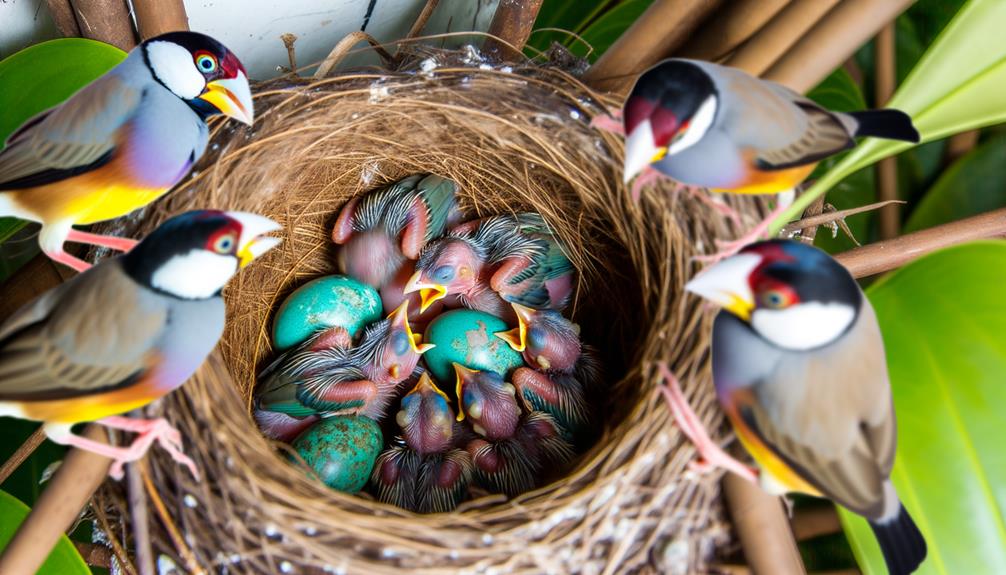
Ensuring the best growth and development of newly hatched Java sparrow chicks requires a carefully balanced and nutrient-rich diet. During the initial days, parents regurgitate partially digested seeds and insects, providing essential proteins and fats. Scientific observations underscore the importance of feeding frequency and nutrient diversity to foster robust health and immunity.
Key dietary components include:
- Protein: Essential for muscle development and overall growth.
- Fats: Necessary for energy and aiding the absorption of fat-soluble vitamins.
- Calcium: Critical for skeletal formation and preventing deformities.
- Vitamins and Minerals: Support metabolic processes and strengthen immune function.
Implementing these dietary guidelines can significantly improve chick survival rates, ensuring a healthy start to their life cycle.
Transition to Independence
The change to independence in Java sparrow chicks marks a crucial phase where fledglings gradually reduce their dependence on parental care and begin to develop autonomy in feeding and other survival behaviors. This shift typically occurs around three to four weeks post-hatching.
During this period, chicks start to explore their surroundings and practice pecking at seeds, imitating the feeding behavior of adult sparrows. Parental feeding decreases as fledglings become more skilled in self-feeding. At the same time, motor skills are refined through frequent flapping and short flights, crucial for evasion from predators.
Conclusion
To sum up, Java sparrow eggs usually require an incubation period of around 14 to 16 days to hatch, depending on ideal nesting conditions and suitable temperature and humidity levels.
Despite possible objections regarding variability in hatching times due to environmental fluctuations, following ideal parameters guarantees higher egg fertility and viability.
Addressing common hatching issues and offering careful post-hatch care greatly improve the survival and development of newly hatched chicks, aiding their progression to independence.

